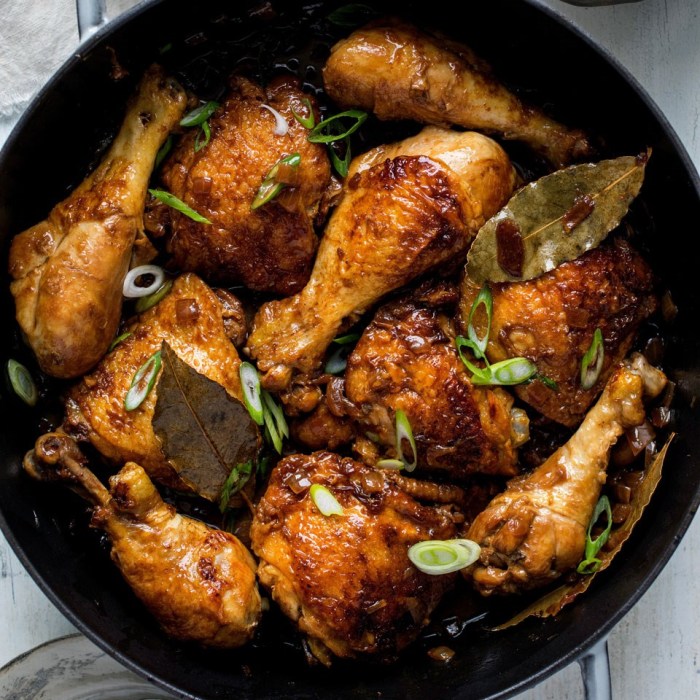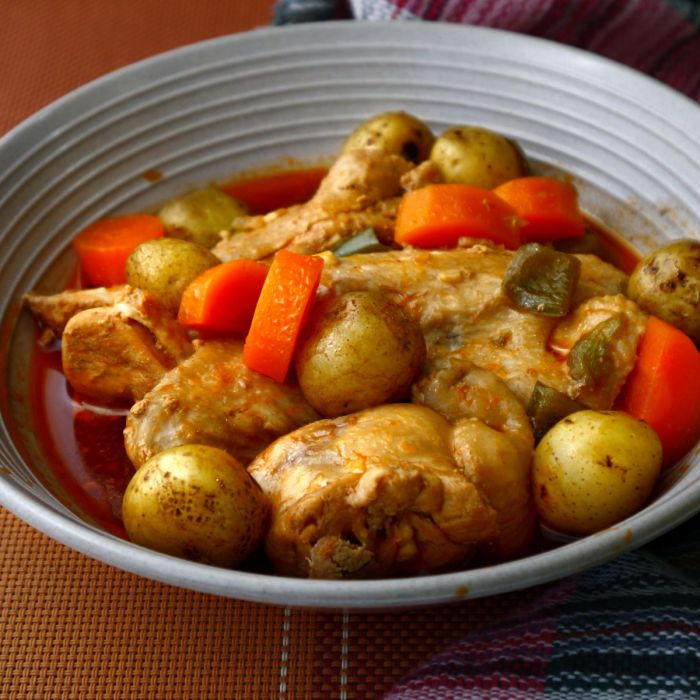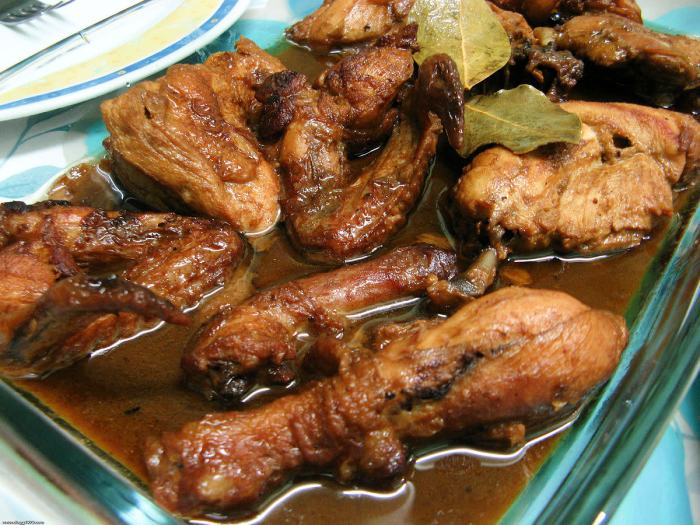Chicken Recipe Filipino Food: A Culinary Journey, delves into the heart of Filipino cuisine, where chicken takes center stage in a vibrant array of dishes. From the familiar Adobo to the lesser-known Kare-kare, Filipino chicken recipes offer a delightful exploration of flavors and textures.
The Philippines, an archipelago of over 7,000 islands, boasts a diverse culinary landscape shaped by centuries of cultural influences. Chicken, a staple ingredient, plays a pivotal role in Filipino cuisine, reflecting the country’s rich history and traditions.
Introduction to Filipino Chicken Recipes
Filipino cuisine, known for its vibrant flavors and diverse culinary traditions, boasts an impressive array of chicken dishes. Chicken, a staple protein source in the Philippines, is incorporated into various recipes, reflecting the country’s rich culinary heritage. From savory stews to flavorful stir-fries, Filipino chicken dishes are a testament to the ingenuity and passion of Filipino cooks.
The prominence of chicken in Filipino food is deeply rooted in the country’s culture and history. Chicken is an affordable and readily available ingredient, making it accessible to all Filipinos. Moreover, chicken is a versatile ingredient that can be prepared in countless ways, catering to diverse palates and dietary needs.
Popular Filipino Chicken Recipes
These are some of the most popular Filipino chicken recipes:
- Adobo:This iconic dish is a national treasure and a staple in Filipino households. It features chicken simmered in a savory sauce made with soy sauce, vinegar, garlic, peppercorns, and bay leaves.
- Lechon Manok:This roasted chicken is a festive favorite, often served during special occasions. It is marinated in a blend of spices and then roasted to perfection, resulting in crispy skin and juicy meat.
- Sinigang:This sour and savory soup is a beloved Filipino comfort food. Chicken is a common protein used in sinigang, along with vegetables like green beans, eggplant, and okra. The sourness of the soup is derived from tamarind, guava, or other souring agents.
- Chicken Kare-kare:This rich and flavorful stew features chicken braised in a peanut-based sauce. It is typically served with a side of bagoong (shrimp paste) and vegetables like eggplant, string beans, and bok choy.
Cultural Significance of Chicken in Filipino Food
Chicken plays a significant role in Filipino culture and traditions. It is often the centerpiece of family meals, gatherings, and celebrations. Chicken dishes are a symbol of hospitality and generosity, reflecting the warmth and kindness of Filipino people. For example, during special occasions like weddings, birthdays, and fiestas, lechon manok is a traditional dish that symbolizes abundance and good fortune.
Further details about pizza sides recipes is accessible to provide you additional insights.
Chicken adobo, a beloved comfort food, is often prepared for family meals and gatherings, bringing people together over a shared culinary experience. Furthermore, chicken is an integral part of Filipino folklore and mythology. In some legends, chickens are associated with good luck, prosperity, and fertility.
The rooster, in particular, is often depicted as a symbol of courage and strength.
Popular Filipino Chicken Dishes

Filipino cuisine is renowned for its diverse and flavorful dishes, and chicken plays a prominent role in many beloved recipes. From classic comfort food to celebratory feasts, chicken is a versatile ingredient that can be prepared in countless ways.
Popular Filipino Chicken Dishes
Here are five popular Filipino chicken dishes that showcase the unique flavors and culinary traditions of the Philippines:
| Dish Name | Description | Ingredients | Preparation Method |
|---|---|---|---|
| Adobo | A classic Filipino dish featuring chicken braised in a savory sauce of soy sauce, vinegar, garlic, and peppercorns. | Chicken pieces, soy sauce, vinegar, garlic, peppercorns, bay leaves, salt, and black pepper | Chicken is marinated in the sauce and then simmered until tender. It can be served with rice or bread. |
| Lechon Manok | A whole roasted chicken, marinated in a blend of spices and herbs, and then roasted until the skin is crispy and golden brown. | Whole chicken, lechon marinade (usually includes soy sauce, vinegar, garlic, ginger, peppercorns, and other spices), salt, and pepper | The chicken is marinated overnight and then roasted in a rotisserie oven or over an open fire. |
| Chicken Tinola | A comforting soup made with chicken, green papaya, and ginger. It is typically served with rice and is often enjoyed during cold weather. | Chicken pieces, green papaya, ginger, onions, garlic, salt, and pepper | The chicken and vegetables are simmered in water until the chicken is cooked through. |
| Sinigang | A sour and savory soup made with a variety of meats, vegetables, and a souring agent, such as tamarind or guava. | Chicken pieces, tamarind, vegetables (such as green beans, eggplant, and okra), onions, garlic, salt, and pepper | The chicken and vegetables are simmered in water with the souring agent until the chicken is cooked through. |
| Chicken Sisig | A sizzling dish made with chopped chicken, onions, chili peppers, and other ingredients. It is typically served with rice and is a popular appetizer or side dish. | Chicken pieces, onions, chili peppers, garlic, soy sauce, vinegar, and other seasonings | The chicken is cooked and then chopped into small pieces. It is then sautéed with the other ingredients until sizzling hot. |
Techniques and Flavor Profiles

Filipino chicken dishes are known for their diverse flavors and cooking techniques. This section will explore the common methods used to prepare chicken in Filipino cuisine and the distinctive flavor profiles that result.
Cooking Techniques
The cooking techniques employed in Filipino chicken dishes are diverse, reflecting the country’s rich culinary heritage. Here are some of the most common methods:
- Adobo:This classic Filipino dish involves braising chicken in a mixture of soy sauce, vinegar, garlic, peppercorns, and bay leaves. The resulting dish is tender, flavorful, and slightly tangy.
- Sinigang:A sour and savory soup, sinigang often features chicken as a protein source. The sourness comes from tamarind, guava, or other fruits, creating a unique and refreshing flavor profile.
- Lechon Manok:This roasted chicken dish is a popular Filipino street food. The chicken is typically marinated with a blend of spices and herbs before being roasted until the skin is crispy and golden brown.
- Kare-kare:This rich and savory stew is made with a peanut-based sauce, often featuring chicken as one of the main ingredients. The dish is typically served with a side of bagoong (shrimp paste), which adds a salty and pungent flavor.
- Ginisang:This stir-fry technique is used to prepare a variety of Filipino dishes, including chicken. Vegetables, garlic, ginger, and other seasonings are often added to the stir-fry, creating a flavorful and balanced dish.
Flavor Profiles
Filipino chicken dishes are known for their complex and satisfying flavor profiles. These flavors are often achieved through the use of a variety of spices, herbs, and ingredients.
- Savory and Umami:Soy sauce, fish sauce, and shrimp paste are common ingredients in Filipino cuisine, contributing to the savory and umami notes in many chicken dishes.
- Sour and Tangy:Vinegar, tamarind, and other fruits are often used to create a sour and tangy flavor profile, as seen in dishes like adobo and sinigang.
- Spicy and Aromatic:Chili peppers, garlic, ginger, and other spices are used to add heat and aroma to Filipino chicken dishes. The level of spiciness can vary depending on the dish and personal preference.
- Sweet and Salty:Sugar is often used to balance the savory and sour flavors in Filipino chicken dishes, creating a harmonious and satisfying taste.
Spices and Herbs
Filipino chicken recipes utilize a diverse array of spices and herbs to enhance their flavor profiles. These ingredients contribute to the unique and aromatic characteristics of these dishes.
- Garlic:A staple ingredient in Filipino cuisine, garlic is often used to create a savory and aromatic base for chicken dishes.
- Ginger:Ginger adds a warm and pungent flavor to chicken dishes, often used in combination with garlic.
- Black Peppercorns:Black peppercorns are a common seasoning in Filipino cuisine, adding a touch of heat and spice to chicken dishes.
- Bay Leaves:Bay leaves provide a subtle, earthy flavor to chicken dishes, particularly in adobo.
- Chili Peppers:Chili peppers are used to add heat and spice to Filipino chicken dishes, ranging from mild to fiery depending on the type of pepper used.
- Cumin:Cumin is often used in Filipino chicken recipes, adding a warm and earthy flavor to the dish.
- Cinnamon:Cinnamon adds a sweet and warm flavor to chicken dishes, often used in combination with other spices.
- Lemongrass:Lemongrass is a fragrant herb used in Filipino cuisine, adding a citrusy and herbal flavor to chicken dishes.
- Cilantro:Cilantro is a popular herb used in Filipino cuisine, adding a fresh and vibrant flavor to chicken dishes.
Serving and Accompaniments

Filipino chicken dishes are typically served with rice, a staple food in the Philippines. The combination of savory chicken and fluffy rice creates a satisfying and comforting meal. The presentation of the dish can vary, but it is common to see the chicken served on a platter with a side of rice, alongside various accompaniments.Accompaniments play a crucial role in enhancing the flavors and textures of Filipino chicken dishes.
They provide a balance of flavors, textures, and colors to the meal.
Popular Accompaniments
Common accompaniments for Filipino chicken dishes include:
- Rice:White rice is the most common accompaniment, often served alongside the chicken. It provides a neutral base that absorbs the flavors of the dish.
- Vegetables:Vegetables such as green beans, bok choy, or eggplant are often included to add freshness and color to the meal. They are typically sauteed or steamed with garlic and onions.
- Sauces and Condiments:Filipino cuisine is known for its diverse range of sauces and condiments. These are used to add flavor and spice to the chicken and rice.
Popular Sauces and Condiments
Here are some of the most popular sauces and condiments used with Filipino chicken dishes:
- Soy Sauce:A staple in Filipino cooking, soy sauce adds umami and saltiness to the dish.
- Fish Sauce:A fermented fish sauce that adds a salty and savory flavor to the dish. It is often used in combination with soy sauce.
- Vinegar:Vinegar is often used to add tanginess and acidity to the dish. It is commonly used in adobo, a popular Filipino chicken dish.
- Patis:A fermented shrimp sauce that adds a salty and umami flavor to the dish. It is often used in combination with soy sauce and vinegar.
- Chili Sauce:Chili sauce is a popular condiment that adds spice and heat to the dish. It is often made from chili peppers, vinegar, and sugar.
- Calamansi Juice:A citrus fruit that adds a tangy and refreshing flavor to the dish. It is often used as a condiment or added to sauces.
Modern Filipino Chicken Recipes: Chicken Recipe Filipino Food

The Filipino culinary scene is constantly evolving, and chicken dishes are no exception. Modern Filipino chefs are reinterpreting traditional recipes, incorporating global influences, and pushing the boundaries of flavor. This has resulted in a vibrant array of contemporary chicken dishes that capture the essence of Filipino cuisine while embracing new culinary trends.
Contemporary Interpretations of Traditional Dishes
Modern Filipino chefs are taking classic chicken dishes and giving them a fresh twist. They are experimenting with different cooking techniques, incorporating unusual ingredients, and elevating the presentation. For example, a traditional adobo might be prepared with a sous vide technique for perfectly tender chicken, or a modern twist on chicken inasal might feature a unique marinade with a hint of citrus or smoked paprika.
These reinterpretations showcase the creativity of Filipino chefs while honoring the heritage of the dishes.
Modern Trends in Filipino Chicken Cooking
Several modern trends are shaping the way Filipino chefs cook chicken.
- Focus on Freshness:There is a growing emphasis on using fresh, locally sourced ingredients, including free-range chicken. This commitment to quality ingredients enhances the flavor of the dishes and supports sustainable agriculture.
- Emphasis on Flavor Profiles:Modern Filipino cuisine is characterized by bold and complex flavor profiles. Chefs are using a wider range of spices, herbs, and aromatics to create unique and memorable flavor combinations. For example, a chicken dish might incorporate a blend of ginger, lemongrass, and chili peppers for a spicy and aromatic experience.
- Fusion Cuisine:Fusion cuisine is a prominent trend in Filipino cooking. Chefs are combining traditional Filipino flavors with international culinary influences to create exciting new dishes. For example, a chicken adobo might be infused with Japanese flavors like soy sauce and mirin, or a chicken kare-kare might be served with a modern twist using a peanut butter sauce with a touch of sriracha.
Examples of Fusion Recipes, Chicken recipe filipino food
Here are a few examples of fusion recipes that combine Filipino and international flavors:
- Chicken Adobo with a Korean Twist:This recipe features a traditional adobo sauce with the addition of gochujang, a Korean chili paste, for a spicy and savory kick.
- Chicken Inasal with a Mediterranean Flair:This recipe combines the classic Filipino marinade with Mediterranean herbs like rosemary and oregano, creating a flavorful and aromatic dish.
- Chicken Kare-kare with a Thai Influence:This recipe features a peanut-based kare-kare sauce with the addition of Thai ingredients like lemongrass, galangal, and kaffir lime leaves, for a fragrant and exotic twist.
Tips for Cooking Filipino Chicken

Cooking Filipino chicken is a delightful culinary adventure, where simple ingredients and traditional techniques come together to create flavorful and satisfying dishes. From the classic adobo to the comforting kare-kare, these recipes are often passed down through generations, making them a cherished part of Filipino culture.
To help you master the art of cooking Filipino chicken, here are some valuable tips.
Selecting and Preparing Chicken
Choosing the right chicken is crucial for achieving authentic Filipino flavors. The most common cuts used in Filipino cuisine are whole chickens, chicken legs, and chicken thighs. These cuts are often preferred because they tend to be more flavorful and tender than breast meat.
When selecting chicken, look for fresh, plump pieces with a slightly pink hue. Avoid chicken that has a strong odor or a slimy texture. Before cooking, it’s essential to properly prepare the chicken. This involves rinsing the chicken under cold water to remove any impurities and patting it dry with paper towels.
For dishes that require marinating, it’s recommended to use a marinade that includes soy sauce, vinegar, garlic, and peppercorns. These ingredients help to tenderize the chicken and infuse it with a rich, savory flavor.
Final Thoughts
Exploring the world of Chicken Recipe Filipino Food, we discover a culinary tapestry woven with passion, creativity, and a deep appreciation for the simple pleasures of good food. From the fragrant spices to the unique cooking techniques, Filipino chicken recipes offer a captivating journey through the heart of Philippine culture.
